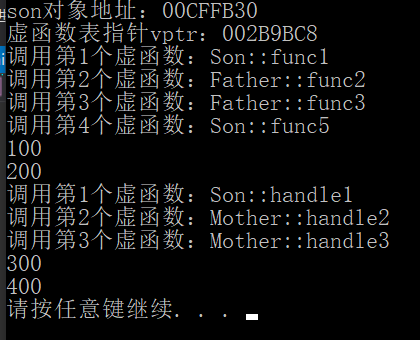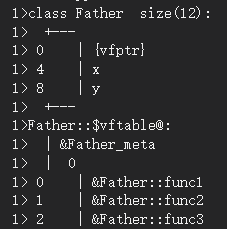虚函数
前言
C++中的虚函数的作用主要是实现了多态的机制。关于多态,简而言之就是用父类型别的指针指向其子类的实例,然后通过父类的指针调用实际子类的成员函数。这种技术可以让父类的指针有“多种形态”这是一种泛型技术。所谓泛型技术,说白了就是试图使用不变的代码来实现可变的算法。比如:模板技术,RTTI技术,虚函数技术,要么是试图做到在编译时决议,要么试图做到运行时决议。
基础:虚函数的使用
虚函数的定义:
在函数的返回类型之前使用virtual
只在成员函数的声明中添加virtual, 在成员函数的实现中不要加virtual
虚函数的继承:
如果某个成员函数被声明为虚函数,那么它的子类【派生类】,以及子类的子类中,所继承的这个成员函数,也自动是虚函数。
如果在子类中重写这个虚函数,可以不用再写virtual, 但是仍建议写virtual, 更可读!
进阶1:虚函数的原理-虚函数表
单个类的虚函数表
#include <iostream>
using namespace std;
class Father {
public:
virtual void func1() { cout << "Father::func1" << endl; }
virtual void func2() { cout << "Father::func2" << endl; }
virtual void func3() { cout << "Father::func3" << endl; }
void func4() { cout << "非虚函数:Father::func4" << endl; }
public: //为了便于测试,特别该用public
int x = 100;
int y = 200;
static int z;
};
typedef void (*func_t)(void);
int Father::z = 1;
int main(void) {
Father father;
// 含有虚函数的对象的内存中,最先存储的就是“虚函数表”
cout << "对象地址:" << (int*)&father << endl;
int* vptr = (int*)*(int*)&father;
cout << "虚函数表指针vptr:" << vptr << endl;
cout << "调用第1个虚函数: ";
((func_t) * (vptr + 0))();
cout << "调用第2个虚函数:";
((func_t) * (vptr + 1))();
cout << "调用第3个虚函数: ";
((func_t) * (vptr + 2))();
cout << "第1个数据成员的地址: " << endl;
cout << &father.x << endl;
cout << std::hex << (int)&father + 4 << endl;
cout << "第1个数据成员的值:" << endl;
cout << std::dec << father.x << endl;
cout << *(int*)((int)&father + 4) << endl;
cout << "第2个数据成员的地址: " << endl;
cout << &father.y << endl;
cout << std::hex << (int)&father + 8 << endl;
cout << "第2个数据成员的值:" << endl;
cout << std::dec << father.y << endl;
cout << *(int*)((int)&father + 8) << endl;
cout << "sizeof(father)==" << sizeof(father) << endl;
Father father2;
cout << "father的虚函数表:";
cout << *(int*)(*(int*)&father) << endl;
cout << "father2的虚函数表:";
cout << *(int*)(*(int*)&father2) << endl;
system("pause");
return 0;
}
执行效果:

VS的对象内存分布分析:
项目的命令行配置中添加: /d1 reportSingleClassLayoutFather

手绘内存分布:

对象内,首先存储的是“虚函数表指针”,又称“虚表指针”。
然后再存储非静态数据成员。
对象的非虚函数,保存在类的代码中!
对象的内存,只存储虚函数表和数据成员
(类的静态数据成员,保存在数据区中,和对象是分开存储的)
添加虚函数后,对象的内存空间不变!仅虚函数表中添加条目
多个对象,共享同一个虚函数表



 浙公网安备 33010602011771号
浙公网安备 33010602011771号